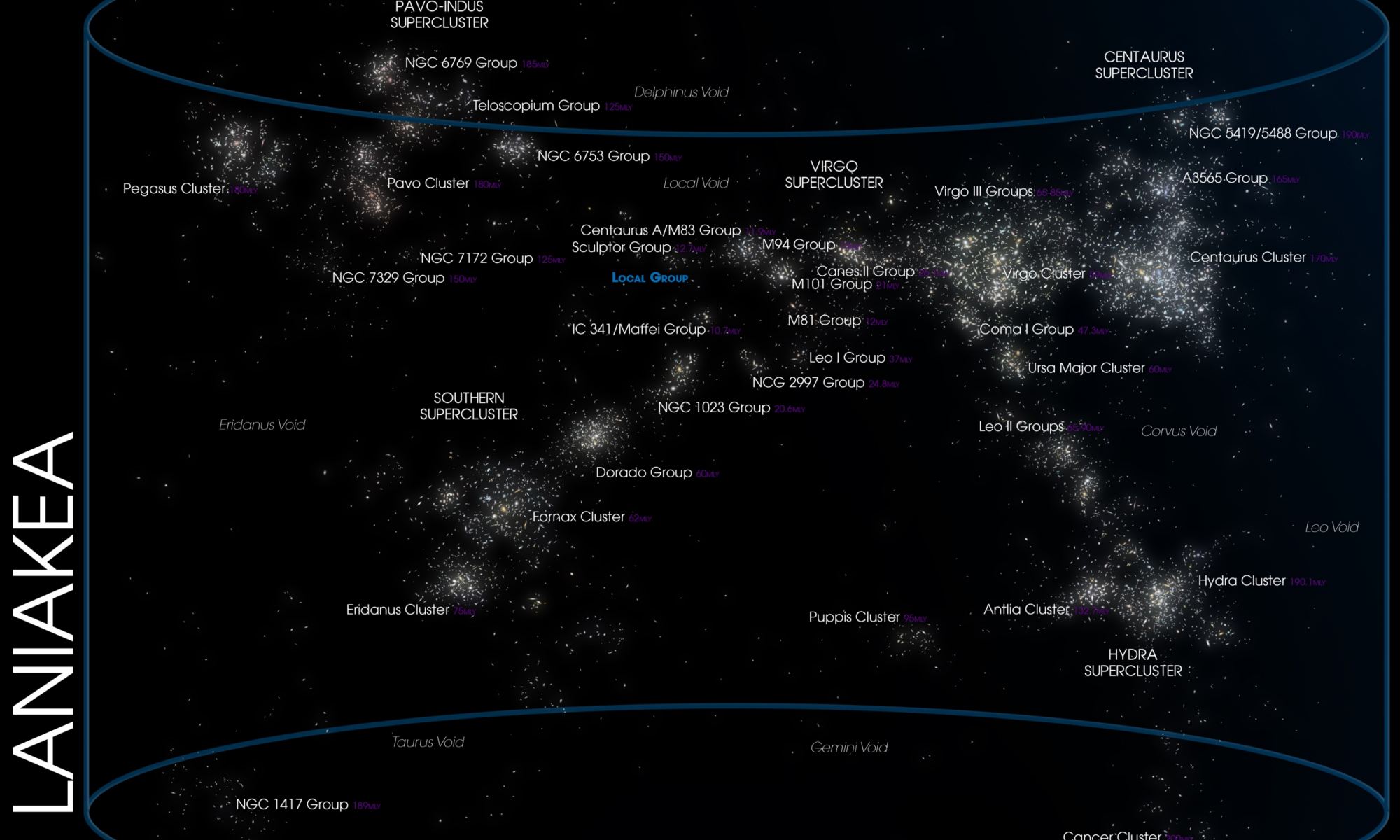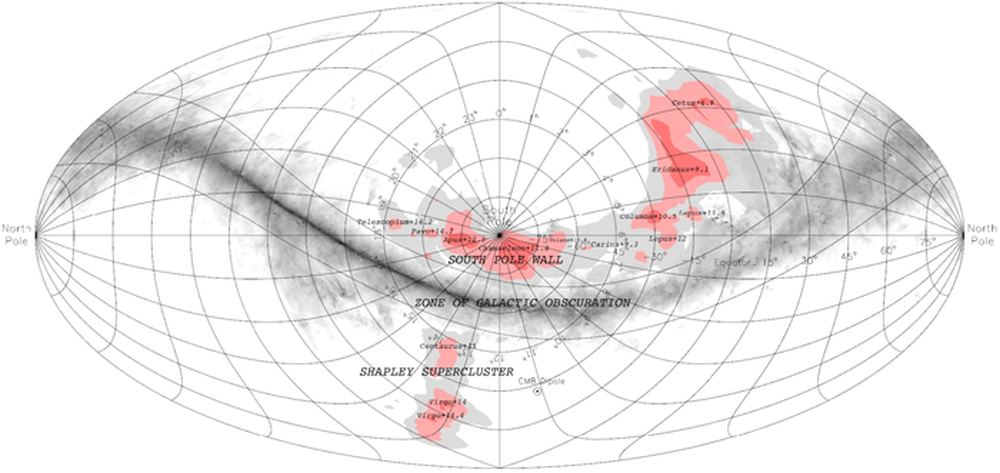By eye, it’s impossible to pick out the exact boundaries of the superclusters, which are among the largest structures in the universe. But that’s because they are not defined by their edges, but by the common motion of their components.
Continue reading “What Makes a Supercluster?”Astronomers Have Mapped Out an Enormous Structure in the Universe Called the South Pole Wall
Galaxies aren’t spread evenly throughout space. They exist in groups, clusters, and superclusters. Our own Milky Way galaxy exists in an impossibly vast structure called the Laniakea supercluster. Laniakea was defined in 2014, and it contains over 100,000 galaxies.
Now a team of astronomers have discovered another immense feature beyond Laniakea, called the South Pole Wall.
Continue reading “Astronomers Have Mapped Out an Enormous Structure in the Universe Called the South Pole Wall”New Map Shows the Motion of all the Galaxies in Our Supercluster
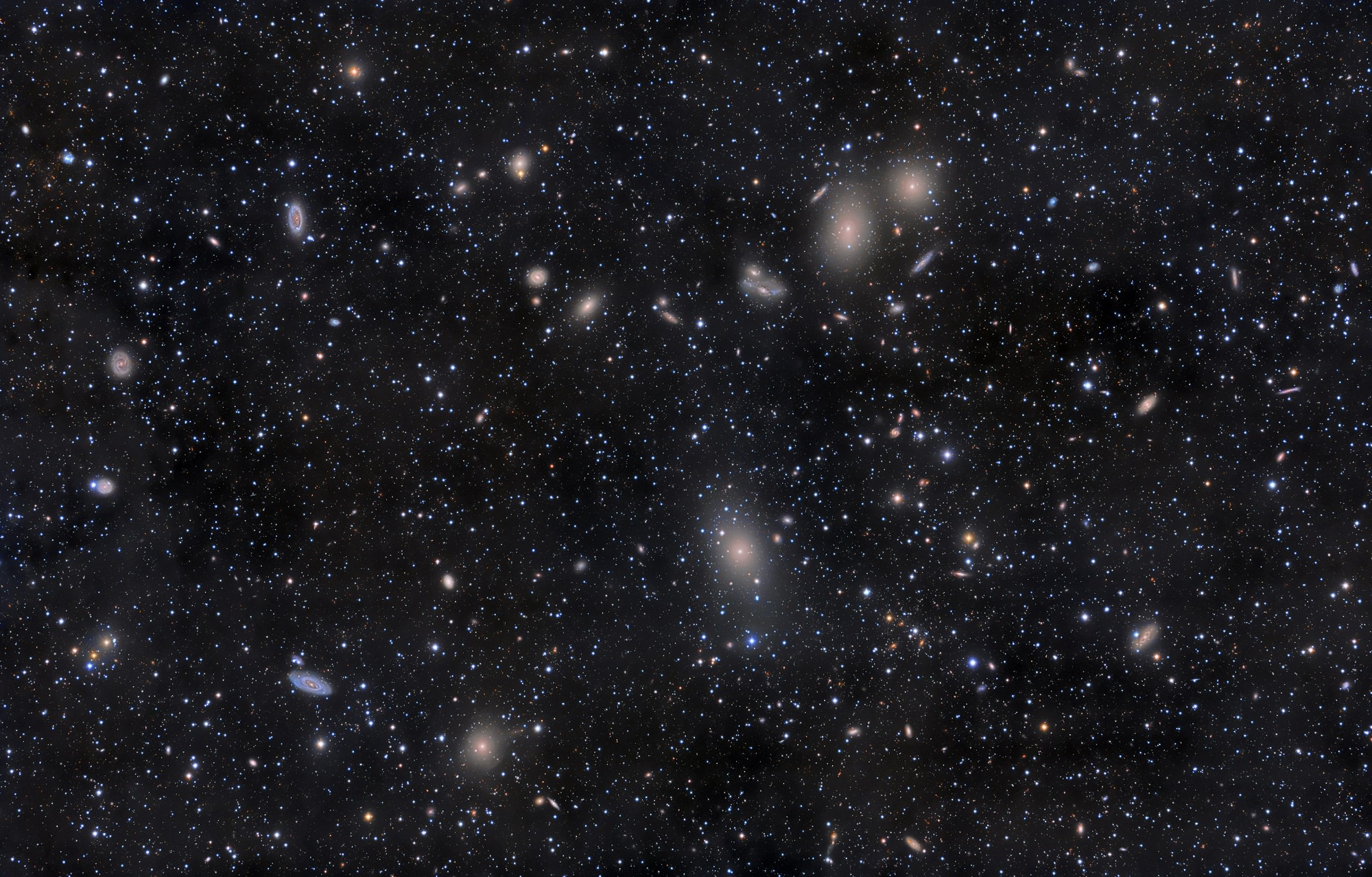
For almost a century, astronomers have understood that the Universe is in a state of expansion. This is a consequence of General Relativity, and the rate at which it is expanding is known as the Hubble Constant – named after the man who first noticed the phenomena. However, astronomers have also learned that withing the large-scale structures of the Universe, galaxies and clusters have also been moving closer and relative to one other.
For decades, astronomers have sought to track how these movements have taken place over the course of cosmic history. And thanks to the efforts of international team of astronomers, the most detailed map to date of the orbits of galaxies that lie within the Virgo Supercluster has been created. This map encompasses the past motions of almost 1,400 galaxies within 100 million light years of space, showing how our cosmic neighborhood has changed.
The study which details their research recently appeared in The Astrophysical Journal under the title “Action Dynamics of the Local Supercluster“. Led by Edward J. Shaya of the University of Maryland, the team included members from the UH Institute of Astronomy, the Racah Institute of Physics in Jerusalem, and the Institute for Research of the Fundamental Laws of the Universe (IRFU) in Paris.
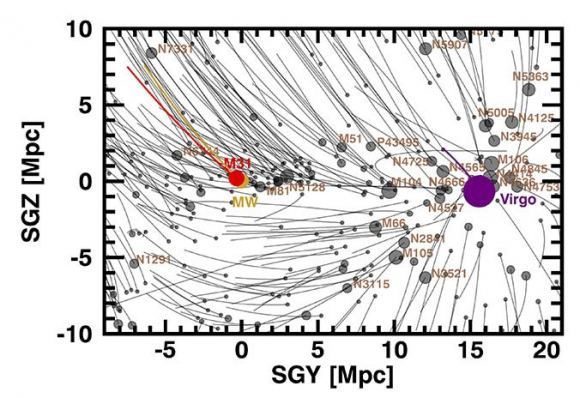
For the sake of their study, the team used data from the CosmicFlows surveys, a series of three studies that calculated the distance and speed of neighboring galaxies between 2011 and 2016. Several members of the study team were involved in these surveys, which they then paired with other distance and gravity field estimates to construct a massive flow study of the Virgo Supercluster.
From this, they were able to create computer models that charted the motions of almost 1,400 galaxies within 100 million light years, and over the course of 13 billion years (just 800 million years after the Big Bang). As Brent Tully, an astronomer with the UH Institute of Astronomy and a co-author on the study, explained in a UH press release:
“For the first time, we are not only visualizing the detailed structure of our Local Supercluster of galaxies but we are seeing how the structure developed over the history of the universe. An analogy is the study of the current geography of the Earth from the movement of plate tectonics.”
What they found was that their models fit the present day velocity flow well, meaning that the structures and speeds they observed in their models fit with what has been observed from galaxies in the present day. They also determined that within the area of space they mapped, the main gravitational attractor is the Virgo Cluster – which is located about 50 million light years away and contains between 1300 and 2000 galaxies.
Moreover, their study indicated that more than a thousand galaxies have fallen into the Virgo Cluster in the past 13 billion years, while all galaxies within 40 million light-years of the cluster will eventually be captured. At present, the Milky Way lies just outside this capture zone, but both the Milky Way and the Andromeda Galaxy are destined to merge in the next 4 billion years.
Once they do, the fate of the resulting massive galaxy will be similar to the rest of the galaxies in the area of study. This was another takeaway from the study, where the team determined that these merger events are merely part of a larger pattern. Basically, within the region of space they observed, there are two overarching flow patterns. Within one hemisphere of this region, all galaxies – including the Milky Way – are streaming towards a single flat sheet.
At the same time, every galaxy over the entire volume of space is moving towards gravitational attractors that are located far beyond the area of study. They determined that these outside forces are none other than the Centaurus Supercluster – a cluster of hundreds of galaxies, located approximately 170 million light years away in the Centaurus constellation – and the Great Attractor.
The Great Attractor is located 150 million light years away, and is a mysterious region that cannot be seen because of its location (on the opposite side of the Milky Way). However, for decades, scientists have known that our galaxy and other nearby galaxies are moving towards it. The region is also the core of the Laniakea Supercluster, a region that spans more than 500 million light-years and contains about 100,000 large galaxies.
In short, while the Universe is in a state of expansion, the dynamics of galaxies and galaxy clusters indicate that they still gravitate into tighter structures. Within our cosmic neighborhood, the main attractor is clearly the Virgo Cluster, which is affecting all galaxies within a 40 million light-year radius. Beyond this, it is the Centaurus Supercluster and the Great Attractor (as part of the larger Laniakea Supercluster) that is tugging at our strings.
By charting this process of attraction that has been taking place over the past 13 billion years, astronomers and cosmologists are able to see just how our Universe has evolved over the course of the majority of its history. With time, and improved instruments that are capable of looking even deeper into the cosmos (such as the James Webb Space Telescope) we are expected to be able to probe even further back towards the beginning of the cosmos.
Charting how our Universe has changed over time not only confirms our cosmological models and verifies predominant theories about how matter behaves on the largest of scales (i.e. General Relativity). It also allows scientists to predict the future of our Universe with a fair degree of certainty, modelling how galaxies and superclusters will eventually come together to form even larger structures.
The team also created a video showing the results of their study, as well as an interactive model that let’s users examine the frame of reference from multiple vantage points. Be sure to check out the video below, and head on over to the UH page to access their interactive model.
Further Reading: University of Hawaii, The Astrophysical Journal
This is the One of the Largest Structures We Know of in the Universe
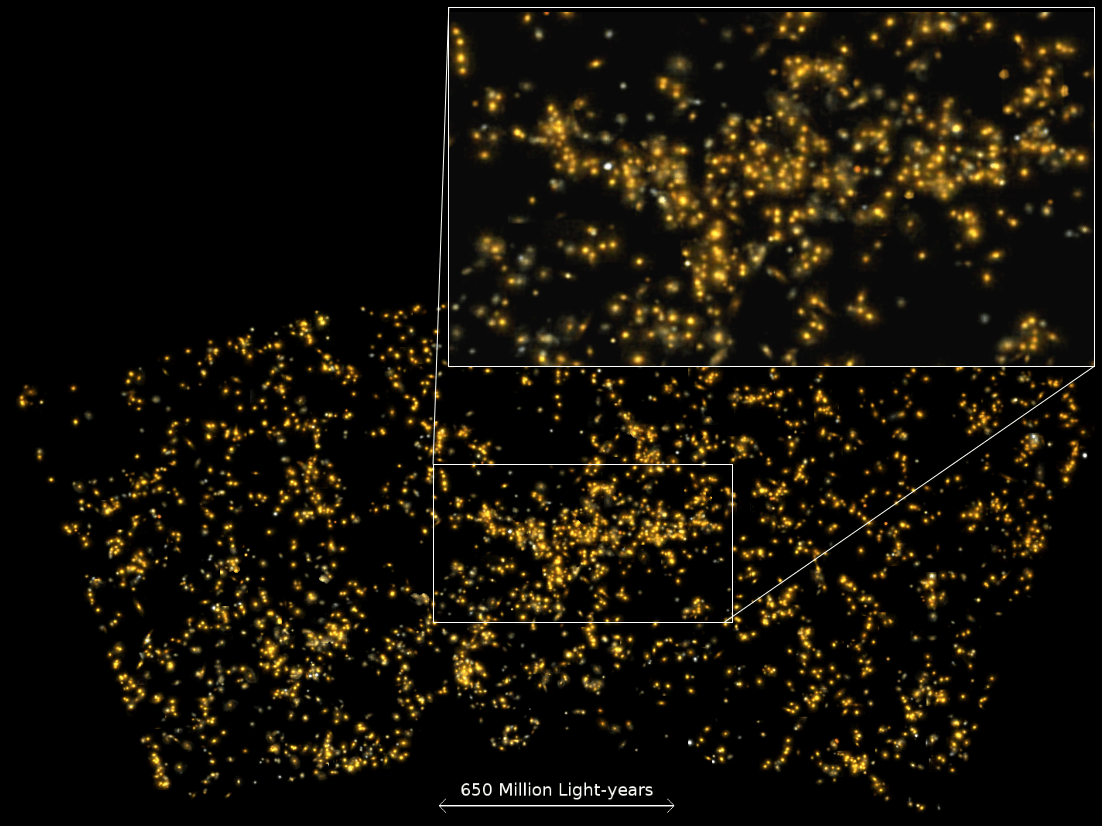
The Milky Way Galaxy, which measures 100,000 to 180,000 light years (31 – 55 kiloparsecs) in diameter and contains 100 to 400 billion stars, is so immense that it boggles the mind. And yet, when it comes to the large-scale structure of the Universe, our galaxy is merely a drop in the bucket. Looking farther, astronomers have noted that galaxies form clusters, which in turn form superclusters – the largest known structures in the Universe.
The supercluster in which our galaxy resides is known as the Laniakea Supercluster, which spans 500 million light-years. But thanks to a new study by a team of Indian astronomers, a new supercluster has just been identified that puts all previously known ones to shame. Known as Saraswati, this supercluster is over 650 million light years (200 megaparsecs) in diameter, making it one the largest large-scale structures in the known Universe.
The study, which recently appeared in The Astrophysical Journal under the title “Saraswati: An Extremely Massive ~ 200 Megaparsec Scale Supercluster“, was conducted by astronomers from the Inter University Center for Astronomy & Astrophysics (IUCAA) and the Indian Institute of Science Education and Research (IISER), with assistance provided by a number of Indian universities.
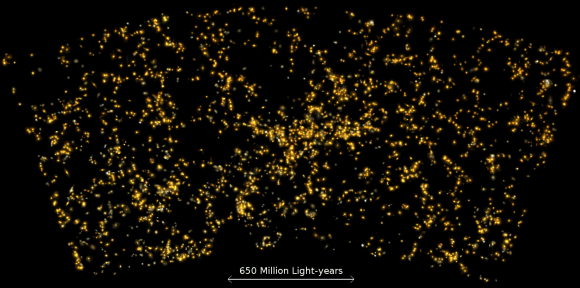
For the sake of their study, the team relied on data obtained by the Sloan Digital Sky Survey (SDSS) to examine the large-scale structure of the Universe. In the past, astronomers have found that the cosmos is hierarchically assembled, with galaxies being arranged in clusters, superclusters, sheets, walls and filaments. These are separated by immense cosmic voids, which together create the vast “Cosmic Web” structure of the Universe.
Superclusters, which are the largest coherent structures in the Cosmic Web, are basically chains of galaxies and galaxy clusters that can extend for hundreds of millions of light years and contain trillions of stars. In the end, the team found a supercluster located about 4 billion (1226 megaparsecs) light-years from Earth – in the constellation Pisces – that is 600 million light-years wide and may contain the mass equivalent of over 20 million billion suns.
They gave this supercluster the name “Saraswati”, the name of an ancient river that played an important role in the emergence of Indian civilization. Saraswait is also the name of a goddess that is worshipped in India today as the keeper of celestial rivers and the goddess of knowledge, music, art, wisdom and nature. This find was particularly surprising, seeing as how Saraswati was older than expected.
Essentially, the supercluster appeared in the SDSS data as it would have when the Universe was roughly 10 billion years old. So not only is Saraswati one of the largest superclusters discovered to date, but its existence raises some serious questions about our current cosmological models. Basically, the predominant model for cosmic evolution does not predict that such a superstructure could exist when the Universe was 10 billion years old.

Known as the “Cold Dark Matter” model, this theory predicts that small structures (i.e. galaxies) formed first in the Universe and then congregated into larger structures. While variations within this model exist, none predict that something as large as Saraswati could have existed 4 billion years ago. Because of this, the discovery may require astronomers to rethink their theories of how the Universe became what it is today.
To put it simply, the Saraswati supercluster formed at a time when Dark Energy began to dominate structure formation, replacing gravitation as the main force shaping cosmic evolution. As Joydeep Bagchi, a researcher from IUCAA and the lead author of the paper, and co-author Shishir Sankhyayan (of IISER) explained in a IUCAA press release:
‘’We were very surprised to spot this giant wall-like supercluster of galaxies… This supercluster is clearly embedded in a large network of cosmic filaments traced by clusters and large voids. Previously only a few comparatively large superclusters have been reported, for example the ‘Shapley Concentration’ or the ‘Sloan Great Wall’ in the nearby universe, while the ‘Saraswati’ supercluster is far more distant one. Our work will help to shed light on the perplexing question; how such extreme large scale, prominent matter-density enhancements had formed billions of years in the past when the mysterious Dark Energy had just started to dominate structure formation.’’
As such, the discovery of this most-massive of superclusters may shed light on how and when Dark Energy played an important role in supercluster formation. It also opens the door to other cosmological theories that are in competition with the CDM model, which may offer more consistent explanations as to why Saraswati could exist 10 billion years after the Big Bang.
One thing is clear thought: this discovery represents an exciting opportunity for new research into cosmic formation and evolution. And with the aid of new instruments and observational facilities, astronomers will be able to look at Saraswait and other superclusters more closely in the coming years and study just how they effect their cosmic environment.
Further Reading: IUCAA, The Astrophysical Journal
Our Place in the Universe: The Most Detailed Map Yet
Astronomy and the other space sciences are the best branches of science for pure eye candy. Biology is great, but who wants to watch videos of a cell dividing? Over and over again. Not me, and not you either, I’ll bet.
This new video from Futurism.com shows our place in the Laniakea Supercluster. Superclusters are the largest-scale structures in the universe, and next to them, we are indeed puny creatures. Our Milky Way galaxy is but a tiny dot in an unremarkable corner of Laniakea.
Thanks to Futurism.com, Nature.com, and R. Brent Tully at the University of Hawaii, we can see better than ever how we Milky Way inhabitants fit into the larger structure of the Universe.
This video is actually a spiffy new edit of an older video, with explanatory voice-over. Check it out.
What Is The Biggest Thing in The Universe?
Think big. Really big. Like, cosmic big. How big can things in the Universe get? Is a galaxy big? What about a supercluster? What is the biggest thing in the Universe?
Our observable Universe is a sphere 96 billion light-years across, and the entire Universe might be infinite in size. Which is a hoarders dream walk-in closet space stuffed full of “things”. It’s loaded down with so much stuff, we’ve even given up naming things individually and now just spew out a list of letters and numbers to try and keep track of it all.
So, as is traditional, in a fit of adolescent OCD and one-upmanship reserved generally for things like tanks, planes and guns, we’re drawn to the question… What’s the biggest thing in the Universe. Well, 14 year old Fraser Cain, put down your copy of “Weapons and Warfare Volume 3” which you picked up at the dollar store as part of an incomplete set, as this is going to get a little tricky.
It all depends on what you mean by a “thing”. The biggest physical object is probably a star. The largest possible red giant star could be as big as 2,100 times the size our Sun. Placed inside our own Solar System, a monster star like this would extend out past the orbit of Saturn. That’s big, but we might be able to get even bigger if we’re willing to get past the idea that a “thing” has to be a homogeneous physical object.
Consider the regions around supermassive black holes. Within our own galaxy, things are pretty quiet, but around actively feeding black holes, there can be disks of material with such temperature and density that they act like the core of a star, fusing hydrogen into helium. Which, purely based on high volumetric density of pure awesome, I’m going to call a thing. An accretion disk around a quasar could be light days across, extending well past the orbit of Pluto and killing us all, if you dumped it in our Solar System.
If we’re going to be all philosophical about what constitutes a “thing” and you’re not all fussy about physical structure and just want a collection of material held together by gravity, then we can really can make some leaps and bounds in our “who’s got the biggest” measuring contest. Our own galaxy extends up to 120,000 light-years across.
There are much larger galaxies, ones that make the Milky Way look like that cat leash pendant from Men In Black 2. And ours is just one contained within a much larger cluster of galaxies known, rather unimaginatively, as the Local Group. Don’t let the centrist name fool you, this cluster contains around 50 galaxies and measures more than 10 million light-years across.
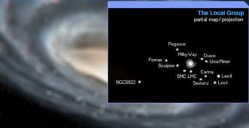
And we’re just getting started. The Local Group is one part of the Virgo Supercluster. A massive galactic structure that measures 110 million light-years apart. In 2014, astronomers announced that the Virgo Supercluster is just one lobe of an even larger structure, beautifully known as Laniakea, or “Immeasurable heaven” in Hawaiian. The name originated from Nawa’a Napoleon, an associate professor of Hawaiian Language at Kapiolani Community College. It honors the Polynesian sailors using “heavenly knowledge” navigating the Pacific Ocean, reminding us that romance is still alive and well in space and astronomy. Laniakea is centered around the Great Attractor – a mysterious source of gravity drawing galaxies towards it.
I almost forgot about our size contest. So who’s got the biggest space thing? According to buzzkill Ethan Siegel from the Starts With a Bang blog, you can’t actually have a structure that’s as big as Laniakea, and call it a thing. The fine-print reality is that the expansion of the Universe is being accelerated by dark energy. These galaxies are being pushed apart by dark energy faster than gravity can pull them together. So they’d never be able to form into a single object given enough time.
In other words, the largest possible object is a collection of galaxies at the exact size where gravity is just strong enough to overcome the expansive force of dark energy. Beyond that, everything’s getting spread apart, and it’s for our purposes we’re actually going to draw a line and say it’s not quite right to call it a thing. Unless you’d suggest a giant expanse of nothing is a thing… but let’s save that for another episode.
So what do you think? Do you feel like it’s right to call superclusters like Laniakea “a structure”?

